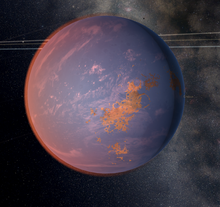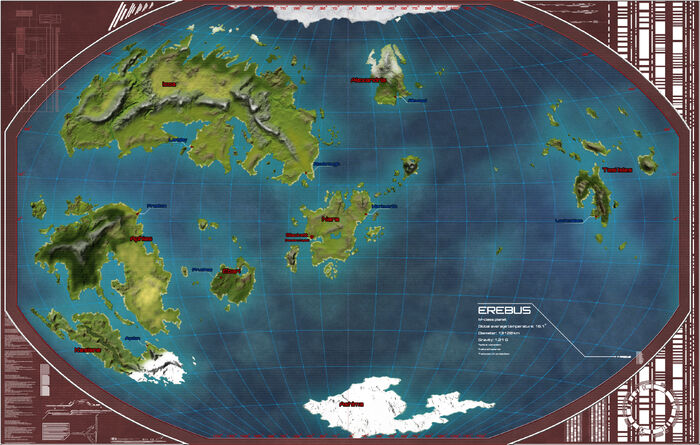
Erebus (pronounced erry-bus) is a supergaian world with an atmosphere similar to Earth but it is slightly larger with heavier gravity. Alongside a surface area of 855 million square km it has a radius of 8247km, a density of 6.18 g/cm3 and a mass of 2.43 Earths with surface gravity of 1.45 Gs, an escape velocity of 15.3 km. It orbits Imhotep at 1.27 AU with an orbital velocity of 28.4 km/s. One year on Erebus lasts 485 standard days or 554 21-hour Erebus days. The atmospheric pressure is lower than earth's (0.8x) with a mass of 4.92E+18kg.
Geology[]
Tectonic activity is higher on Erebus than on Earth due to the higher gravity and greater radioactive decay. The interior of the planet is warmer due to a relatively smaller surface to volume ratio making it harder for heat to escape from planet, resulting in a large molten core, a thicker mantle and a thinner crust that buckles and slips more easily. This results in more severe and more frequent volcanic activity and earthquakes.
Massive valleys and canyons are found on Erebus, particularly the Great Glen on Keslane, where two continental plates are beginning to rift apart. Frequently these are created by rivers flowing quicker than on Earth due to the higher gravity.
The tallest mountain is “Myaa”, located on the southern continent of Aphias. In general mountain ranges do not approach heights seen on Earth due to higher rates of weathering and gravity.
All types of volcanism present on Earth are also found on Erebus including flood basalts, Shield volcanoes and stratovolcanoes. Nara is the least geologically active section of the planet, however, a gigantic extinct volcano is located in the northeastern portion of the continent. Plates on Erebus tend to move around 1.6x the speed of plates on Earth.
This frequent volcanic activity has resulted in the concentration of large numbers of rich ore deposits close to the surface of Erebus, productive volcanic soils and easily accessible gem sources as well as access to volcanic stone for building material and other industrial uses. Most of the planet has easy access to geothermal energy.
Composition[]
- 73.1% Silicates
- 26.1% Nickel Iron
- 0.0446% Water
- 0.778% Organics
Surface[]
Erebus is made up of 5 larger continents and 3 smaller ones. In order of size:
- Icoa
- Aphias
- Keslane
- Nara (However, if the sea level was slightly lower the Tasi Isles would be much larger)
- The Tasi Isles
- Alexandria
- Ebari
- Ashima
Icoa is the largest continent and the only large landmass entirely in the Northern Hemisphere of the planet. It can be broadly divided into 3 climate zones. The Coastal South, the Arid Centre and the Northern Forests. The coastal south has a Mediterranean style climate with warm, dry summers and mild, wet winters. The topography is mostly hilly. The arid centre is cut off from a lot of rainfall by a range of mountain belts running along it, including the highest mountain on Erebus, Myaa at 12,500m. It has a semi-arid or steppe climate meaning hot to warm all year round and little rainfall. Almost entirely plains apart from the mountain belts. Finally you have the Northern Forests, while not true trees in the Terran sense they are similar enough to be called forests. They have a climate similar to Earth’s Taiga.
Aphias is the largest southern continent and has two main climate zones. The west hosts the largest rainforest-like biome on Erebus before transitioning into a Savannah-like biome and the Eastern Desert. There are some significant mountains in the Western forest.
Keslane is a a cool and damp continent found in the south, covered by dense forests. A stormy shallow sea exists between it and Aphias. A large rift valley runs NW to SE along the continent. The South is partially covered in ice and snow.
Nara was the landing site of the Blackett and where the first settlers of Erebus were concentrated. It is part of the same climatic regime as the south of Icoa, with warm, dry summers and mild, wet winters. The land is mostly plains with the odd valley. A chain of volcanic islands lies to the Northeast.
The Tasi Isles are an archipelago not dissimilar to Indonesia on Earth. A warm shallow sea surrounds numerous islands which are covered in thick rainforests. A wet and dry season occurs each year, with ferocious hurricanes sweeping across from the west.
Alexandria is the largest of the 3 smaller continents, and the most northerly of them. It has a cold and dry tundra style climate although some of the southern portions are fairly habitable.
Ebari is surrounded by the 4 largest continents and has a cool and wet climate, not unlike Newfoundland on Earth.
Ashima: Is the coldest and most southerly continent on the planet and has had no significant exploration. Only continent entirely covered by ice.
Climate and Atmosphere[]
Erebus has an average temperature of 16.5 degrees celsius compared to the Earth’s 15-ish, despite the thinner atmosphere (0.8x Earth's) present. As the thinner atmosphere scatters less blue light than that of Earth's, the sky is slightly dimmer than that of Earth but with a distinct purple hue.
Erebus has an axial tilt of 17°, causing seasonal climate variation to be slightly less extreme than those on Earth. However as Erebus’ atmosphere is thinner it has a lower thermal inertia than Earth’s atmosphere, resulting in greater diurnal variations in temperature and faster-moving winds.
Average wind velocity is further enhanced by the relatively high rotation rate, resulting in larger Coriolis forces, with more violent tornadoes, hurricanes, monsoons and water-spouts exacerbated by the fact there is more thermal energy within the oceans as the average temperature of Erebus is higher.
Due to the higher gravity, raindrops drop out of the sky before they can grow very large. This does result in rainbows being fairly pathetic on Erebus. Electrical storms are more intense on Erebus, due to a greater proportion of dust particles within the atmosphere due to volcanism and extreme weathering. High latitude auroras are incredibly spectacular, due to the immensely strong magnetic field of the planet.
Flora and Fauna[]
Erebus (despite the name) is completely safe for human habitation and possess a terran-compatible ecology with life possessing left-handed proteins and the same amino acids as those found on Earth. Terrestrial macrofauna exhibits bilateral symmetry with an internal skeleton and at first glance would not look out of place on Earth.Life in general on Erebus is more evolved than on Earth due to the higher mutation rates (a product of the higher UV radiation levels) and complex multi-cellular life appearing roughly 200 million years before Earth’s did. More symbiotic relationships with microfauna have been developed with herbivores able to break down cellulose more easily thanks to symbiotic gut bacteria.
Most vertebrates are however hexapodal (six-legged) instead of quadrupedal and possess a "ladder spine". A ladder spine has twin neural channels encased in bone running down both sides of the torso with jointed support posts connecting them resulting in greatly improved stability and strength on high-gravity worlds at a slight cost of flexibility. Oddly, powered flight never evolved on Erebus, despite evolving multiple times on Earth.
Erebian vertebrates have five-chambered hearts, with a small ventricle to supply blood for the central nervous system. Due to the high gravity, major veins are capable of peristalsis to assist returning blood flowing to the heart.
In place of a diaphragm, they have multiple sheets of muscle that contract lobes of the lung in sequence, resulting in minimal dead space in the lungs and a constant chest volume. It also allows them to clear foreign matter from their lungs more easily.
Compared to terran vertebrates, they are stronger with greatly enhanced endurance but consume far more food. This is partially countered in warm-blooded animals by the ability to lower body temperature several degrees during famine, which results in vastly reduced energy requirements but makes the animal lethargic (although body temperature can rapidly rise if a burst of activity is needed).
When exposed to cold temperatures, Erebian warm-blooded animals pre-warm blood flowing to the core from the extremities to mitigate heat loss. Most animals sweat and pant, with their lungs operating as evaporative surfaces.
The vast majority of Erebian organisms are capable of regenerating lost limbs and organ,s, including injured nerves. It’s not uncommon for social animals to share food and tear off the badly mangled joints of injured pack members to allow clean regrowth.
Erebian life is also better placed to survive trauma. Torn arteries clench shut around the injury with valves in veins preventing the backflow of blood to the injury, greatly reducing blood loss and therefore survival rates. Bones are stronger and more resilient than Terran equivalents, with greater tensile strength and fracture resistance. Stronger tendons and ligaments support the bones.
Erebian plants have a higher efficiency photosynthesis pathway than terrestrial plants, with minimal water and carbon dioxide consumption. This seems to have evolved in response to past geological periods of carbon dioxide deficiency.
Most animals are more heavily built than terran equivalents, with thicker limbs and no long-necked giraffe like animals. Larger animals almost universally have the pillar-erect posture (as seen in rauisuchians).
The largest land animal known to have ever lived on Erebus is the modern day “Plains Dragon”, named after its resemblance to mythological dragons and habitat. Found within the great grasslands of Icoa, a fully grown Plains Dragon can grow to 7.5m long with a height of 2.5m and a weight of 7 tonnes. Highly aggressive and intelligence, it makes a fearsome cavalry mount.
The Plains Dragon is hexapodal, like much of the other life on Erebus with the characteristic ladder spine common of all Erebusian vertebrates. Heavily built, the Plains Dragon is covered in bony plates that extend over much of the Plains Dragon's skin and vicious foot long spikes emanating from the neck.

Despite being heavily armoured, the Plains Dragon can chase down prey at 30 mph. One early explorer described it as the biological equivalent of an armoured assault vehicle.
Map[]
